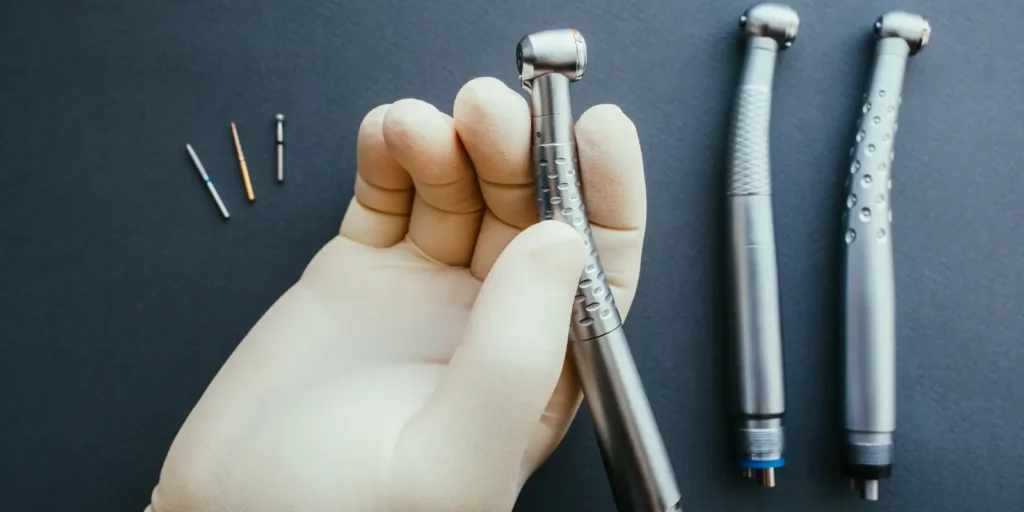
Table of Contents
Get Dental Catalogue PDF On Your Email
How to Choose the Perfect Dental Handpiece for Your Practice
Selecting the ideal dental handpiece for your office is essential to providing patients with secure and effective service. Generic or rebranded handpieces of inferior quality have a number of flaws that can cause procedure times to increase, the quality of the work to decline, and the possibility of injury to you or your patients to rise. Then, when problems happen, you may frequently become irate due to poor customer service.
The success and general quality of dental operations performed in your office can be enhanced by making the appropriate handpiece investment. The benefits and drawbacks of various dental handpiece types—namely, air-driven versus electric and high-speed versus slow-speed—will be discussed in this article. Next, we’ll go over the things to think about and the procedures to follow when selecting the best tool for your dental office.
DENTAL HANDPIECE TYPES
Dental professionals employ a variety of handpieces depending on their specialization and the operations they conduct. To find out more about the differences between items for general dentistry and specialist clinics, visit our guide to the most popular types of dental handpieces. Here, we go over the benefits and drawbacks of various handpiece kinds.
Handpieces driven by air
Air-driven handpieces continue to dominate the market in the United States, despite the increasing usage of electric handpiece devices, particularly at dentistry schools. Understanding how dental handpieces work can help practitioners make informed decisions about which type best suits their needs. Air-driven models operate by using compressed air to rotate the cutting tool, providing high-speed performance ideal for various procedures. However, the growing adoption of electric handpieces, which use an electric motor for consistent torque and quieter operation, indicates a shift towards more advanced and versatile dental technologies.
Benefits of air-powered handpieces:
Speed: Removing hard tooth tissue is quicker and less painful when done at a high rotational speed of 400,000 rpm.
Weight: Less weight improves tactile control, lessens hand fatigue, and allows for anatomy-driven clinical feedback.
Size: A smaller head makes it easier to reach the oral cavity.
Affordability: Less expensive up-front and ongoing than electric. LubeFree technology and in-office turbine replacement from Star make maintenance even simpler.
Autoclavability: They are easy to clean and sterilize due to their comparatively simpler construction.
Air-driven handpieces' drawbacks:
Lack of torque: When the cutting bur makes contact with tougher materials, such crowns, a higher speed usually produces a lower torque, which is a drawback.
Noise and vibration: May make a high-pitched noise and occasionally vibrate excessively, upsetting the patient as well as the dentist. A design that use ceramic bearings rather than stainless steel can lessen this.
Overuse of aerosols: The level of aerosol produced by high-speed air-driven handpieces has significantly decreased in acceptability, particularly in the wake of the COVID-19 pandemic.
END OF STOCK ELECTRONIC HANDPIECES
Electric handpiece devices are becoming more and more common, and some leaders in practices think this is the direction dentistry is going in. Here are some benefits and drawbacks of this kind of dental supply. For more detailed information and to explore a wide range of options, check out the Carrothcp Dental Catalogue Book.
Electric handpiece benefits:
Consistent torque: Electric power generates more torque, which is why it’s perfect for operations like crown removal and cutting through tougher materials like noble metals and zirconia.
Smooth Operation: The internal gear design makes it possible for attachments to run silently and smoothly, which increases patient and dentist comfort.
Variable speed control: The majority feature a controller with settings that let dentists power various attachments, like endodontic, high-speed, and low-speed, by adjusting speed and torque without using a foot pedal.
Flexible: It is simple to switch between a low-speed attachment for polishing and finishing and a high-speed attachment for preparing teeth.
Cons of using electric handpieces:
Weight: Compared to air-driven handpieces, they are heavier, which may result in hand fatigue over extended procedures.
Size: It may be more difficult to enter the oral cavity if a person has a relatively large head.
Overheating: Patients may burn from the overheating caused by poorly maintained handpieces that begin to fail.
Cost: Currently, the price of an air-driven handpiece is around three times that of a controller, motor, and attachments. Moreover, handpiece repair is more costly and difficult due to the abundance of moving parts.
Maintenance: Compared to air-driven handpieces, electric handpieces need more frequent lubrication and cleaning of the motor and transmission. Motors require labor-intensive maintenance since they are typically not autoclavable.
Both high-speed and low-speed (or slow-speed) procedures can be performed with air-driven or electric handpieces. Here, we contrast some of these two handpiece types’ advantages and disadvantages.
QUICK-CHANGE HANDPIECES
High-speed handpiece benefits:
Effective: Dental professionals may extract tooth tissue more rapidly and more efficiently with high-speed handpieces, which also helps to soothe patients.
Precise: Their small head size and light weight allow for precise control, which makes them perfect for tasks requiring fine motor skills.
Flexible: Suitable for a range of restorative operations, including as drilling, shaping, and cutting.
The drawbacks of handpieces with fast speed:
Limited torque: When pressure is applied to a bur, its limited torque renders it less efficient for procedures requiring greater force, like crown removal.
Noise and vibration: Some patients find the high-pitched sound made by high-speed handpieces uncomfortable. They may shake too much, which can lead to enamel breaking and uneven edges.
Overabundance of aerosols: The amount of aerosol produced by high-speed air-driven handpieces might be problematic when compared to slower-speed handpieces.
Shorter lifespan: High-speed handpieces need to be replaced more frequently than low-speed handpieces, typically every six to twelve months, due to wear and tear from continuous high-speed use.
HANDPIECES WITH LOW SPEED OR SLOW SPEED
Low-speed handpiece benefits:
Versatile: Used for a wide range of procedures, such as endodontic and implant work, polishing, finishing, correcting crowns and bridges, and soft decay removal.
Strong: Able to provide more torque than high-speed handpieces, which makes them useful for operations like root canals that call for more control.
Cooler: Produce less heat than high-speed handpieces, lowering the possibility that the tooth will sustain thermal damage.
Quieter: Compared to high-speed handpieces, they make less noise and vibration, which increases patient and dentist comfort.
The drawbacks of handpieces with low speed:
Weight: Compared to high-speed handpieces, these are often bigger and heavier, which might lead to hand fatigue during prolonged treatments.
Inefficient: Compared to their high-speed cousins, their slower pace renders them less effective for tasks requiring a lot of cutting.
Higher maintenance: Compared to high-speed handpieces, air-driven and electric slow-speed handpieces need greater upkeep. If maintenance procedures aren’t followed correctly, they may malfunction or function slowly.
Conclusion
Choosing the right dental handpiece involves balancing the benefits and drawbacks of air-driven versus electric and high-speed versus low-speed options. Consider your practice’s specific needs, the types of procedures you perform, and your budget. Investing in high-quality handpieces will enhance the success and quality of dental operations, ensuring patient satisfaction and safety.
By understanding the differences and carefully evaluating your options, you can select the perfect dental handpiece that aligns with your practice’s requirements and provides the best care for your patients.
Ready to find the ideal dental handpiece for your practice? Visit Carrothcp to explore our comprehensive range of high-quality dental handpieces and accessories. Enhance your practice with the best tools available and ensure the highest standard of care for your patients today.

